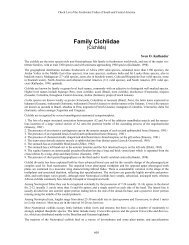Open Access PDF - Sven Kullander
Open Access PDF - Sven Kullander
Open Access PDF - Sven Kullander
Create successful ePaper yourself
Turn your PDF publications into a flip-book with our unique Google optimized e-Paper software.
Prominent rostral fold on maxilla (Fig. 1b). (9)<br />
Unique colour pattern with three dark vertical<br />
bars on side, developing from three dark blotches<br />
in juveniles.<br />
Field markings. Distinguishing characteristics useful<br />
for field identification include: deeply notched<br />
dorsal-fin margin; densely scaled caudal and anal<br />
fin; large mouth with lower jaw projecting; small<br />
scales; frequently continuous lateral line; large,<br />
conspicuous ocellus at base of caudal fin.<br />
Descriptive synopsis. Body elongate to moderately<br />
deep (21.3-34.6 % SL; Fig. 2), laterally compressed.<br />
Mouth large, terminal, low in position,<br />
caudally wider than rest of head. Ascending<br />
processes of premaxilla extending to behind nostril<br />
but not reaching anterior margin of orbit. Caudal<br />
part of maxilla well exposed, extending to below<br />
orbit. Lower jaw prognathous; articulation below<br />
orbit. Upper lip fold interrupted symphysially,<br />
but with thickened connection with opposite side<br />
fold; caudad a simple fold, not curled inwards.<br />
Lower lip fold discontinuous symphysially; widest<br />
medially, much reduced in width before attachment<br />
caudally to maxilla and dorsally to<br />
premaxillary tip (‘African type’ lips, <strong>Kullander</strong>,<br />
1986: fig. 9). Postlabial skin fold (rostral cap)<br />
discontinuous with lachrymal margin, extended<br />
as skin fold laterally on maxilla. Opercular bones<br />
entire. Preopercle with uneven straight vertical<br />
free margin and rounded ventral margin.<br />
Jaw teeth small, recurved, simple, pointed,<br />
smaller and gradually shorter linguad, densely<br />
arranged in well-defined bands that widen symphysiad,<br />
teeth absent symphysially; upper jaw<br />
band wider anteriorly than lower jaw band.<br />
Scales ctenoid. Scales absent from cheek below<br />
line continuing labial margin of lachrymal caudad;<br />
above that several irregular rows of scales, those<br />
98 99 100 101 102 103 105 107 109 % continuous<br />
61<br />
4<br />
7<br />
5<br />
71<br />
50<br />
36<br />
1 1 1 15<br />
1 2 2 4 4 4 2 2 78<br />
85<br />
Ichthyol. Explor. Freshwaters, Vol. 17, No. 4<br />
Body depth in per cent of SL<br />
35<br />
30<br />
25<br />
kelberi<br />
ocellaris<br />
pleiozona<br />
monoculus<br />
mirianae<br />
orinocensis<br />
nigromaculata<br />
melaniae<br />
thyrorus<br />
piquiti<br />
vazzoleri<br />
pinima<br />
intermedia<br />
jariina<br />
temensis<br />
295<br />
Fig. 2. Box plot of body depth : SL ratio in species of<br />
Cichla arranged in order of decreasing medians to the<br />
right.<br />
dorsally and rostrally of about size of flank scales,<br />
ventrally smaller; patch of cycloid scales ventrally;<br />
dorsal cheek scale rows continued onto<br />
first infraorbital to level of anterior margin of<br />
orbit; 4 vertical rows of scales behind orbit; behind<br />
upper margin of orbit scales absent from narrow<br />
zone caudad to preopercle. Scales absent from<br />
preopercle. Opercle, subopercle save for narrow<br />
free margin where scales absent, and interopercle<br />
posteriorly, densely scaled. Body scales small;<br />
slightly larger on flanks and abdomen than along<br />
dorsal trunk margins and ventrally anterior to<br />
pelvic-fin base. Scales along middle of side (E1<br />
scale row, Table 2), 67-128. Lateral line scales on<br />
trunk slightly smaller than adjacent scales. Prepelvic<br />
scales very small save for posteromedial<br />
about flank scale size. Scales absent from wide<br />
area above orbits; predorsal squamation reaching<br />
rostrad to not quite anterior margin of orbit. Scales<br />
absent from medial portion of predorsal midline.<br />
Extension of absence of scales from predorsal<br />
midline corresponding to nuchal protuberance<br />
when present and reduced in larger specimens<br />
Lateral line continuous, with 71-109 scales<br />
(Table 3), or discontinuous with upper and lower<br />
lateral line overlapping, with 35-69 and 29-51<br />
scales respectively (Tables 4-5). Flank lateral line<br />
continued on caudal fin by a few scales mainly




